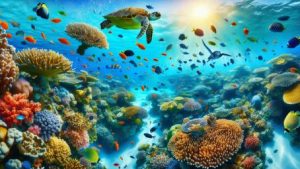
Welcome to the underwater wonderland of Palau, where snorkeling enthusiasts can witness an aquatic tapestry woven with vibrant corals, bustling marine life, and clear azure waters. We are passionate about showcasing the ethereal beauty beneath the waves of this Pacific paradise. Set off on a snorkeling journey that promises to be as enlightening as it is breathtaking, teeming with biodiversity and natural splendors.
Palau’s Pristine Waters: A Snorkeler’s Paradise
Palau’s allure lies in its crystal-clear seas, home to some of the world’s most pristine coral reefs. Here, the warm waters play host to an array of ecosystems, making it a prime location for snorkelers of all skill levels. Whether you’re gliding over shallow lagoons or delving into deeper realms, you’ll find a diverse marine landscape waiting to be explored.
Reef Ecosystems and Their Inhabitants
- The Outer Reefs – These barriers protect the tranquil inner waters and are bustling with large pelagic fish and breathtaking drop-offs.
- The Inner Reefs – Teeming with life, the inner reefs offer a colorful display of soft and hard corals, home to hundreds of small fish species in a kaleidoscope of colors.
- The Mangroves – Acting as nurseries for many species, these areas are crucial for the lifecycle of numerous marine creatures and offer a unique snorkeling experience.
Marine Life Highlights in Palau
Palau’s waters boast over 1,500 fish species and 700 species of corals and sponges. As you snorkel, you might encounter:
- Manta Rays – Majestic and graceful, these gentle giants are a sight to behold in the cleaning stations.
- Turtles – Hawksbill and green turtles are often spotted on the reefs, offering an enchanting snorkeling companion.
- Sharks – Blacktip, whitetip, and grey reef sharks cruise the drop-offs, a thrilling encounter for the adventurous.
- Tropical Fish – A dizzying array of fish, including the Palauan butterflyfish, moorish idols, and parrotfish, animate the coral gardens.
Each snorkeling trip presents an opportunity for discovery, with National Geographic describing Palau as one of the world’s best underwater experiences.
Conservation Efforts to Preserve Palau’s Marine Biodiversity
Palau is pioneering in marine conservation, establishing the first shark sanctuary and part of its waters as a marine protected area (MPA). Efforts by organizations like the Pew Charitable Trusts aim to ensure the longevity of Palau’s unique marine environment. Snorkelers are encouraged to respect the underwater world by following eco-friendly practices, ensuring this aquatic paradise remains unspoiled for generations.
Planning Your Snorkeling Adventure in Palau
At Palau Explorer, we thrive on helping you create unforgettable snorkeling experiences. Here are some tips to get the most out of your Palau adventure:
- Choose the Right Season: Palau’s snorkeling conditions are optimal between November and April, with calmer seas and better visibility.
- Select a Professional Guide: Palau’s knowledgeable guides can lead you to the best spots and enrich your journey with their expertise on local marine ecology.
- Respect the Environment: Help protect Palau’s marine life by not touching the corals or chasing the wildlife, maintaining a safe and respectful distance at all times.
Embarking on a snorkeling trip to Palau is more than just a vacation; it’s an immersive dive into one of the Earth’s most extraordinary natural habitats. Let Palau Explorer be your companion in unveiling the secrets of this underwater Eden. Ready to explore? Contact us and let the adventure begin!
FAQs
Is Palau in the coral triangle?
Yes, Palau lies right in the heart of the coral triangle, the global epicenter of marine biodiversity holding over 75% of all known coral species on Earth across the Indo-Pacific region.
What fish are in Palau?
Palau waters host over 1,500 validated fish species from tiny neon gobies to giant manta rays, along with endangered dugongs, saltwater crocodiles and four Pacific turtle varieties – truly an astonishing marine spectacle.
How has Palau kept the biodiversity of the reefs on the islands?
Strict marine protections like banned fishing zones give over-harvested local species safe repopulation spaces while regulating destructive tourism practices preserves delicate habitats at sustainable scales avoiding decline plaguing more commercialized destinations.
What are the four major aquatic ecosystems in Palau?
The Rock Islands limestone archipelago, vast outer barrier and fringing reefs, numerous marine lakes plus mangrove estuaries each ecologically unique while collectively hosting astounding volumes of marine megafauna dazzling snorkelers and divers immersed there daily across all habitats.
